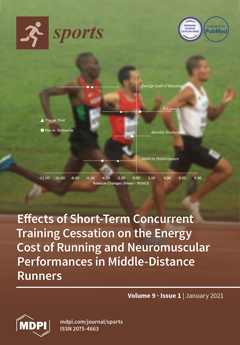The acute effects of cold-water endurance swimming on the respiratory system have received little attention. We investigated pulmonary responses to cold-water endurance swimming in healthy recreational triathletes. Pulmonary function, alveolar diffusing capacity (
DL
CO), fractional exhaled nitric oxide (FE
NO
[...] Read more.
The acute effects of cold-water endurance swimming on the respiratory system have received little attention. We investigated pulmonary responses to cold-water endurance swimming in healthy recreational triathletes. Pulmonary function, alveolar diffusing capacity (
DL
CO), fractional exhaled nitric oxide (FE
NO) and arterial oxygen saturation by pulse oximetry (SpO
2) were assessed in 19 healthy adults one hour before and 2.5 h after a cold-water (mean ± SD, 10 ± 0.9 °C) swim trial (62 ± 27 min). In addition, 12 out of the 19 participants measured pulmonary function, forced vital capacity (FVC) and forced expiratory volume in one second (FEV
1) 3, 10, 20 and 45 min post-swim by maximal expiratory flow volume loops and
DL
CO by the single breath technique. FVC and FEV
1 were significantly reduced 3 min post-swim (
p = 0.02) (
p = 0.04), respectively, and five of 12 participants (42%) experienced exercise-induced bronchoconstriction (EIB), defined as a ≥ 10% drop in FEV
1. No significant changes were observed in pulmonary function 2.5 h post-swim. However, mean FE
NO and
DL
CO were significantly reduced by 7.1% and 8.1% (
p = 0.01) and (
p < 0.001), respectively, 2.5 h post-swim, accompanied by a 2.5% drop (
p < 0.001) in SpO
2. The absolute change in
DL
CO correlated significantly with the absolute decline in core temperature (
r = 0.52;
p = 0.02).
Conclusion: Cold-water endurance swimming may affect the lungs in healthy recreational triathletes lasting up to 2.5 h post-swim. Some individuals appear to be more susceptible to pulmonary impairments than others, although these mechanisms need to be studied further.
Full article






